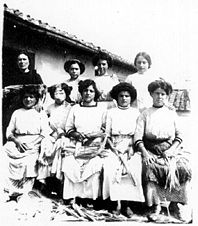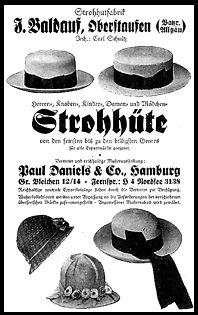
Straw plaiters
A series of events have been dedicated over the last few years to this flourishing activity and production that was to bring such prosperity to Signa and district in this period. A high point in these events came with the opening of the Domenico Michelacci Museum of Straw and Plaiting, in Via degli Alerti n.11, Signa on May 17th 1997, the first of its kind in Italy and set up with the help of some of the industries in the area, the Archeological Group and the full support of the local authorities. As we said, Signa was once the capital of articles created in straw, especially hats, and, like every important capital in the world, it had a King, or rather a founder, who was, in this case, Domenico Michelucci, from whom the museum takes its name. "Bolognino", as he was called, because he came from the city of Bologna, arrived in Tuscany in 1714 and settled down in Signa.
Although straw manufacture in fact already existed here, it was of poor quality, though some of the cargo boats that carried goods back and forth between Florence and Pisa tried taking a selection of locally produced hats to the port of Leghorn. Here they had no trouble in selling them to passing travellers who particularly liked the ingenious way the plaited straw had been used to make them. However Michelacci soon realised that the best way to gain a foothold on the market was to produce merchandize of a better quality than it was possible to create with the normal rather thick type of straw, which was what was left over after the wheat had been harvested, and that better and more refined materials were called for. His experiments, tests and research went on for about four years, though without any tangible results, until he suddenly had a brainwave: it far was better to grow a type of corn that would give long thin stalks rather than concentrate mainly on the wheat crop. Therefore, in the face of criticism and general disapproval about such tiny - and empty - ears of wheat, deprived, as people said, of "the grace of God", he grew a crop of slender, delicate stalks. However once these stalks had been bleached by the sun and dew, the nimble fingers of the plaiters transformed them into hats such as had never been seen before, so that even those who had doubted him most were forced to admire them. Michelacci took his hats to Livorno and soon managed to sell them to the passing travellers as well as get an incredible number of requests and orders for the following year as well. This was to be the promising start of what was to become a real industry for the manufacture of straw hats, bringing great prosperity to the area thanks to the birth of a large number of firms which were soon exporting their products all over the world: to Paris, London, Dresden, New York, Vienna, Cairo, Malta, Mexico, Lima, Panama, Guatemala, Havana, Berlin, Constantinople and many other places. Unfortunately this positive trend eventually came to a halt with the oncome of economic difficulties and the war, apart from changes in fashion. This led to a notable decline although there are still several firms working in this sector in the district.
The local authorities are convinced that if a few changes in policy could be introduced this craft could flourish again as it did in the past. However, let us return to the Museum which really is well worth visiting; it contains a huge amount of material, too much in fact to display in the ten rooms it occupies at present, though it will soon be moving to larger headquarters in the centre of Signa, in Via Ferroni, which previously housed the offices of the town council. This is why the decision was made, to start with at least, only to display exhibits connected with the creation and manufacture of hats, which formed the basic production anyway; it includes a series of panels and photographs of the period, a wide variety of examples of plaiting, some more complicated than others, that bring this magic period back to life, as well as period machinery; these are all donations from local firms, some of which are still active, like the Giulio Corti & F.llo of Signa (now Corti srl) or other firms that have since closed, like Franceschini, founded at San Piero a Ponti in 1820 by Antonio Franceschini from Signa who, after the crisis in 1929/1930, was forced to sell up the firm on February 5th 1932 (though fortunately his heirs kept some of the equipment), as well as the firm of Marzi and several others. Some exhibits have been brought in from elsewhere, among them a very interesting loom from Fiesole which the straw weavers (immortalized in one of Telemaco Signorini's paintings recently displayed in the exhibition dedicated to his work in the White Room at the Pitti Palace) used to create "bigherini" (which was a special kind of narrow lace used for trimming ladies' dresses). The hats on display, some of which could quite happily be worn even today, include a really unique exhibit (only three were ever made in this style), that dates from the mid 19th century: a delightful cloche hat that once belonged to one of the Empresses of Austria, perhaps even Sissy herself, and comes from the House of Brugisser.

Advertisement (1929).
Signa is only fifteen kilometres away from Florence, it is an attractive and hospitable town offering excellent cooking and where, in the outskirts, opera lovers can find Villa Bellosguardo which once belonged to Enrico Caruso, the famous tenor, and now organizes various musical activities. It's certainly worth the trip. Museum timetable: Closed on Mondays - Tuesdays and Saturdays 9am-12.30pm - Wednesdays, Thursdays and Fridays: 3am-7pm - Sundays by appointment only. Tel. 055/87941.
